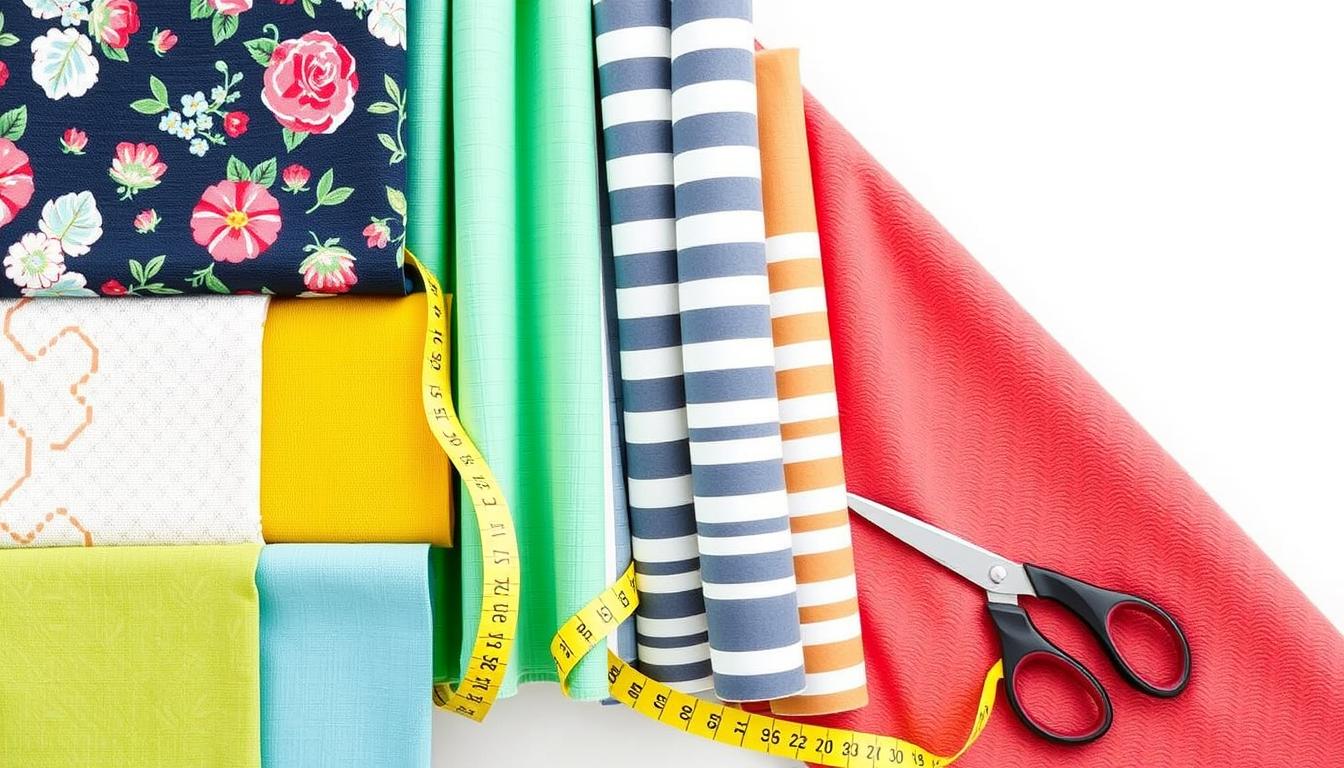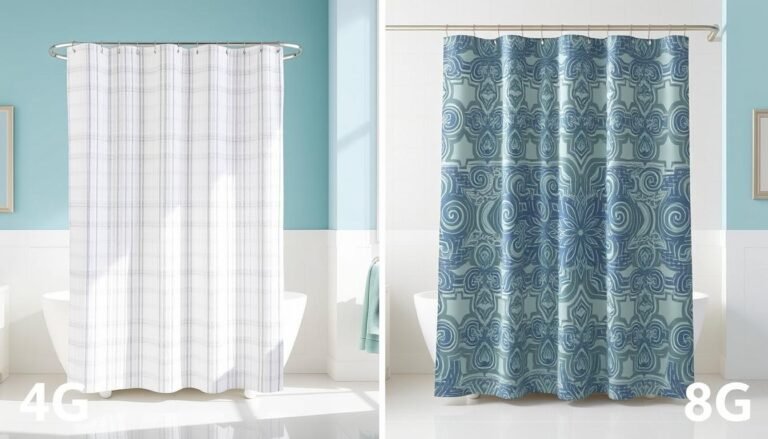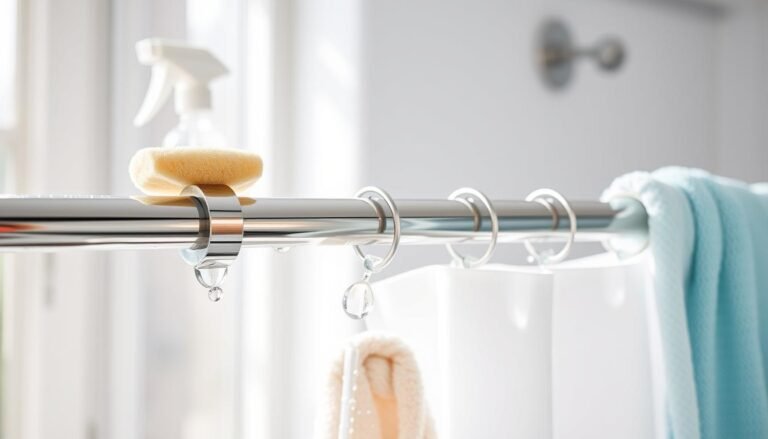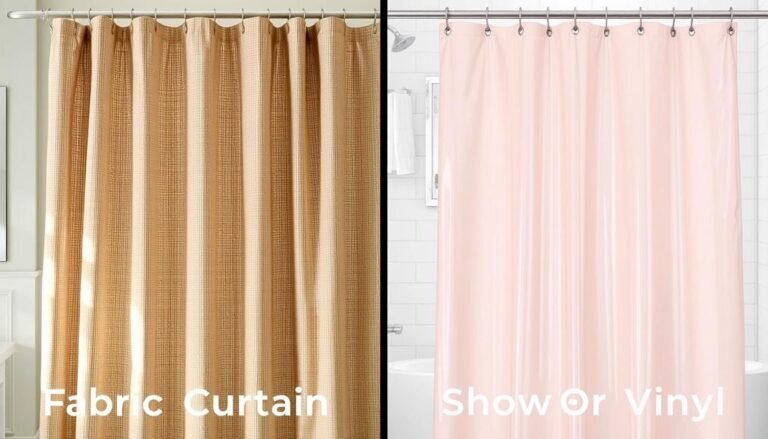Perfect Fabric Yardage for Shower Curtains
Shower curtains are more than just bathroom accessories. In small spaces, they are key to the room’s look and feel. Making your own shower curtain lets you show off your style. It can make your bathroom stand out, whether you like shabby chic, boho, or modern Spanish Revival.
Spoonflower is a great place to find lots of fabric designs. One standout is the Sevilla Blanco Spanish Tile by Heather Dutton. It can really highlight your bathroom’s theme.
If you’re making a standard shower curtain of 72×72 inches, you’ll need about 5 yards of fabric. Remember to add a bit more for hems and seams. This ensures a great fit and professional look. This shower curtain fabric guide will help you pick the best fabric. It also explains how to measure and create an eye-catching DIY shower curtain.
Choosing the Right Fabric for Your Shower Curtain
Choosing the right fabric for your shower curtain matters a lot. Looks are important, but don’t forget about function. You can pick from a variety of fabrics. This includes anything from vintage textiles to linen for a sleek look.
Types of Fabric
Different materials like polyester, microfiber, cotton blend, vinyl, and cotton are popular for shower curtains. Each material has its own benefits. Your choice depends on what you like and need.
- Polyester: Durable and budget-friendly.
- Microfiber: Soft and highly absorbent.
- Cotton Blend: Versatile and easy to maintain.
- Vinyl: Naturally water-repellent, making it good for damp environments.
- Cotton: Provides a natural and classic look.
Benefits of Different Fabrics
Choosing the right fabric does more than just make your bathroom look good. Cotton showers are both beautiful and easy to clean. Vinyl acts as a shield against water, preventing mold and mildew. Each fabric also has specific benefits for shower curtain fabric calculation and shower curtain yardage.
- Polyester: Easy to wash and quick-drying.
- Microfiber: More luxurious feel and high absorbency.
- Cotton Blend: Dresses up your bathroom decor effortlessly.
- Vinyl: Cost-effective and highly functional.
- Cotton: Breathable and provides a soft touch.
Considerations for Waterproofing
It’s important to think about waterproofing when picking fabric for shower curtains. For example, vinyl repels water well. But cotton might need a liner to stay dry and mold-free. Treatments like 3M Scotchgard™ can make fabrics more resistant to water and stains, improving their use.
Knowing the advantages and types of fabric can help you choose wisely. This is true whether you’re figuring out how much fabric you need or just want the best type for your bathroom.
Calculating How Much Fabric for a Shower Curtain
When you calculate shower curtain material, you’ll need to know some basics. These include standard sizes, seam and hem allowances, and the fabric width. This ensures the curtain looks good without any gaps.
Standard Shower Curtain Dimensions
Most shower curtains are 72 inches square, fitting well in any bathroom. Using fabric that is 45” or 54” wide requires about 5 yards. But, with fabric that is 108” or 110” wide, you need just 2 ½ yards.
Seam Allowances and Hems
For a neat and lasting shower curtain, add extra fabric for seams and hems. For a 72” curtain, include 9 inches more for the top and bottom hems. Don’t forget to account for 12 hook openings, needing a 4” interfacing strip at the top.
| Fabric Type | Yardage Needed |
|---|---|
| 45” or 54” wide fabric | 5 yards |
| 108” or 110” wide fabric | 2 ½ yards |
Fabric Width Considerations
The width of your fabric can affect the look of your finished curtain. Standard fabric widths vary between 36 to 60 inches. To get a fuller look, use a fabric 1.5 to 2 times wider than the space it will cover. For standard sizes, joining two 40 inch wide panels may be necessary. If your design has large prints, plan for an extra yard to align the patterns at the seams.
The Process of Measuring Fabric Needed for a Shower Curtain
Getting the right measurements and tools is key for making a shower curtain. Start by collecting all you need and follow a clear measuring guide.
Tools You Need
You’ll need these tools to measure and cut your fabric:
- Reliable sewing machine
- Measuring tape
- Sharp scissors
- Pattern matching tools (if applicable)
Step-by-Step Measuring Guide
To measure your shower curtain fabric correctly, use this guide:
- Measure the shower space: Common shower curtain sizes are 72″ x 72″, 70″ x 70″, and 74″ x 74″. For freestanding tubs, add 12 inches to the width on each side.
- Calculate fabric by panel:
- Center panel: 44-45” wide, 2 yards and 3 inches long.
- Side panels: 18” wide, 6 feet 3 inches long each.
- Account for hems and seams: Include 1 1/2 inches for the top hem and 2 inches for folding under.
- Place buttonholes: Mark twelve buttonholes like those on a standard curtain or liner.
- Calculate total yardage: You need about 4 1/8 yards of 45” or 59” wide fabric.
- Double-check measurements: Make sure everything fits your curtain rod and tub correctly.
Read more about fabric estimation tips for better accuracy in your projects.
DIY Shower Curtain Fabric Estimation
Starting a DIY shower curtain project means you need to guess how much fabric to buy. It’s key to get the amount right, so you have enough for your work but not too much left over.
Custom Size Shower Curtains
Calculating fabric for custom shower curtains is different from the regular sizes. Most shower curtains are 72 inches square. Custom projects need precise measurements. Remember to add an extra inch for seams. This helps make sure your curtain looks great.
Pattern Matching Tips
Pattern matching is crucial if your design has repeating elements. You might need more fabric to keep the design consistent. Make sure the pattern follows one direction. Always buy a little more fabric to handle any surprises in fabric type or dye lots.
Calculating Yardage for Complex Designs
Complex designs need a careful calculation method. For projects like quilts, you divide the fabric width by one piece’s width. You also figure out how many rows you need. Remember to add extra for seams and finishing touches. Using a table to lay out these measures can help:
| Fabric Type | Dimensions | Recommendations |
|---|---|---|
| Woven Polyester/Nylon | Varies by piece | Washable, breathable, often used as liners |
| Heavy Cotton Canvas | Varies by piece | Durable, used in hotels |
| Performance Fabrics | 54 inches width | Ideal for heavy use, upholstery |
For exact measurements, you might want to check this detailed guide about making full-length shower curtains. By following these tips, you can make a beautiful curtain that fits your bathroom just right.
Sewing Tips for Perfectly Made Shower Curtains
Making a professional-looking shower curtain starts before you even sew. Here, we share key shower curtain sewing tips. They’ll help you at each step to ensure your end product looks great.
Prewashing Your Fabric
It’s key to prewash your fabric before measuring and cutting. This step prevents shrinkage and keeps your measurements accurate. For example, the Robert Allen Handcut Shapes in Rain fabric was machine-washed for a relaxed finish, even though it was originally for dry cleaning only.
Constructing Seams and Hems
After prewashing, focus on the seams and hems. Use modern sewing machines for precise stitches. With fabric typically 55″ wide, cutting panels is straightforward without needing to join pieces. Attention to seams and hems is crucial for a flawless finish.
Adding Grommets or Buttonholes
Functional and long-lasting shower curtains need grommets or buttonholes. Most sewing machines have an automatic buttonhole feature. We show how to add buttonholes for shower curtain rings. Choose stylish rings, like ball designs, to match your decor.
With these tips and knowing how much fabric you need, you can make a custom shower curtain yourself. Use our advice to improve your shower curtain’s quality and make it last longer.
Creative Ideas for Using Different Fabrics
Exploring different shower curtain fabrics can make your bathroom special. Think about using outdoor fabrics. They are strong and manage moisture well.
When picking materials, mix polyester stripes with cotton. This adds interesting textures and looks. For example, try Robert Allen Ikat Bands in Rain from Hancock Fabrics. You can find it online for a great price.
To figure out how much fabric you need, plan for up to six yards. It depends on your curtain’s dimensions. Shower curtains usually have 12 evenly spaced grommets. For tall ceilings, look for lengths of 84” or 96” at Bed, Bath & Beyond.
Choosing the right fabric can add a designer touch to your bathroom. Pick vibrant patterns instead of old floral ones. This can turn a plain room into a stylish spot. It mixes beauty with practicality.
| Fabric Option | Yardage Needed | Price per Yard | Availability |
|---|---|---|---|
| Robert Allen Ikat Bands in Rain | 6 yards | $49.99 | Hancock Fabrics |
| Outdoor Fabric | 6 yards | $15.98 | Hancock Fabrics |
| Drop Cloth | 9′ x 12′ | $10-$15 | Lowes |
Fabrics with beautiful finishes can change your shower time. Use different fibers and patterns. Your curtain will show your unique style. With creative fabrics, your bathroom can look like it’s from a design magazine.
Final Touches & Maintenance for Your Custom Shower Curtain
After you finish making your custom shower curtain, it’s all about the details. Good final touches make it perfect. Also, keeping it clean and in good shape is important to make it last.
Make sure the curtain hangs right. It should measure 54 x 78 inches to fit your shower well. You might want a fabric length of about 88-90 inches. This gives room for hems and makes the curtain look neat and last longer.
Cleaning your curtain regularly is key. The type of fabric and any special treatments it has matter. This keeps it looking new and stops mildew. Cutting the fabric correctly also stops mold and keeps your bathroom clean. Use sharp scissors for a clean cut.
Check the curtain’s grommets or buttonholes from time to time. If your curtain is taller than usual, it might need more support. If you changed a curtain using fabric glue or fray stoppers, make sure they’re still holding up. For tips on making a curtain fit well, you can check out these suggestions.
By taking good care of it, your curtain will do its job and add beauty to your bathroom. Following these tips means your bathroom will look great for a long time. For more advice on your home, visit coveradvice.com.

Hey there, I’m Alex Hanson and I’m passionate about all things covers! Whether you’re looking for a car seat cover to protect your vehicle or an oven cover to keep your kitchen clean, I’m here to help. With years of experience in the industry, I have plenty of knowledge and insights to share with my readers. So, if you care about protecting your belongings and making them look their best, you’re encouraged to read my blog as I explore the perfect cover for every need.







